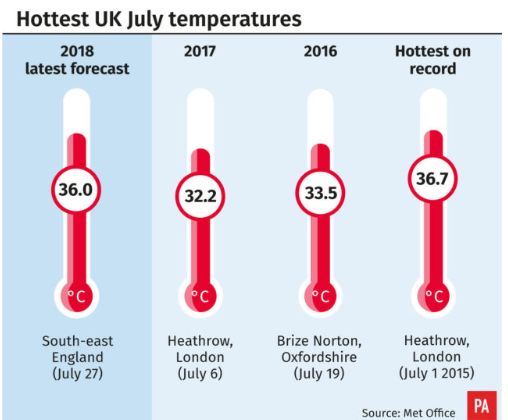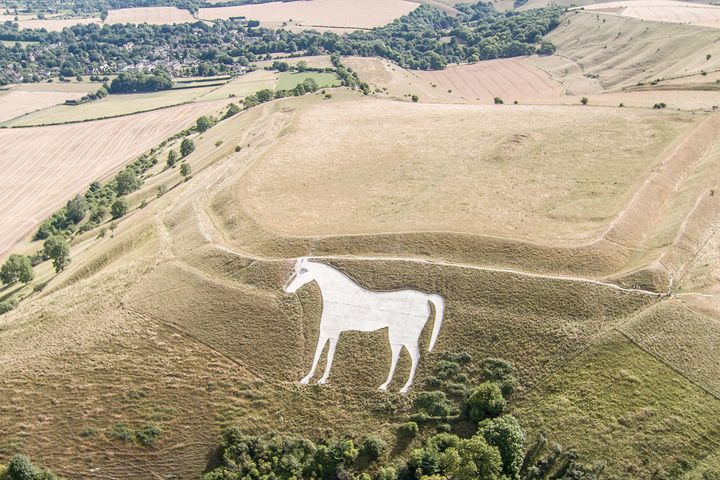Britain’s sweltering start to summer may yet break one final record - the UK’s all-time highest temperature, the Met Office has said.
The high of 38.5C, set in August 2003, could be surpassed on Friday, as could the highest recorded temperature for July – 36.7C – recorded at Heathrow on 1 July 2015.
The mercury is so far forecast to hit 37C on Friday.
The possible record will come just days after the hottest day of 2018 was recorded on Monday – 33.3C at Santon Downham in Suffolk, which led to amber heat health warnings being issued.
Tuesday was slightly cooler, with a high of 31.4C reached in Cavendish, Suffolk.
The Met Office told HuffPost UK on Wednesday that between June 25 and July 25, the UK has experienced 20 days where the temperature has reached 30C.
That followed news earlier this month that Britain had experienced the driest start to summer in 57 years and the longest heatwave in five years.
While the news might send Britons heading for the beaches, the sizzling temperatures are expected to trigger intense thunderstorms in some parts of the country.
Thunderstorm warnings are in place for parts of northern and eastern England and the Midlands for Friday, with people warned of flash flooding, lightning strikes, hail or strong winds.
This could lead to flooding of homes and businesses, difficult driving conditions and potential power cuts, the Met Office said.
Up to 30mm of rainfall in an hour and 60mm in three hours is predicted.
Paul Gundersen, chief meteorologist at the Met Office, said while the UK “could break the all time” UK temperature record on Friday, thunderstorms could break out over some parts of England from Thursday.
“But it is Friday when we see intense thunderstorms affecting many central and eastern areas,” he said.
“Whilst many places will remain dry and hot, the thunderstorms on Friday could lead to torrential downpours in places with as much as 30mm of rainfall in an hour and 60mm in three hours.
“Large hail and strong, gusty winds are also likely and combined, could lead to difficult driving conditions as a result of spray and sudden flooding.”

The weather warnings came as London Mayor Sadiq Khan triggered a “high” air pollution alert for Thursday.
He said: “The heat, combined with London’s toxic air, a lack of cloud cover and emissions travelling from the continent, means I am triggering a ‘high’ air pollution alert today, for tomorrow, under our comprehensive alert system.
“This is the second time in six months that we have had to use the ‘high’ alert system and shows just why air pollution is a public health crisis.”
Air quality alerts will be displayed at bus stops, river piers, on busy roads and at the entrances to London Underground stations.
In high pollution episodes, adults and children with lung problems and adults with heart problems should reduce strenuous physical exertion, particularly outdoors, people with asthma may find they need to use their reliever inhaler more often, and older people should also reduce physical exertion.
Anyone experiencing discomfort such as sore eyes, cough or sore throat should consider reducing activity, particularly outdoors, experts say.
There were also warnings on Wednesday that hundreds of people could die unnecessarily because of a lack of awareness of the rising risk of heatwaves.
Bob Ward, policy and communications manager at the Grantham Research Institute on Climate Change and the Environment at the London School of Economics, said the figure for heat-related deaths was likely to exceed 1,000 based on the extra deaths seen in short hot spells in 2016 and 2017.
An amber heat warning remains in place for parts of England, with people being warned to try to stay out of the sun between 11am and 3pm.
Nurses have warned that some hospital wards have reached more than 30C, leading to patients and relatives passing out or vomiting.
The Local Government Association said social workers, community wardens and maintenance staff are all on high alert to identify those who could be struggling in the heat.
And pet owners have been urged to avoid exercising their dogs and other animals in the hottest parts of the day, due to the risk of burnt paws on scorching pavements, as well as the chance of heatstroke.
Rail journeys are being disrupted by the hot weather as train speeds are
reduced to stop tracks from buckling, with trains on Chiltern Railways between London and Oxford being rescheduled because of high track temperatures.
Speed restrictions were also introduced by Northern Rail on Tuesday and Greater Anglia on Monday.

Following the driest first half of summer on record, farming leaders warned crops are being hit and livestock are having to be fed with feed that should be held for winter as grasslands are parched.
The dry spell has been most prolonged in East Anglia and south east England, where the last day of very widespread rainfall was seen on May 29.
Meanwhile, the heatwave has also seen a day’s cricket lost in the India warm-up match against Essex. The fixture will now be a three-day affair following concerns about the prolonged hot weather.
The heatwave baking Britain comes as extreme hot weather grips northern Europe, with scientists warning that the kind of conditions being seen at the moment in much of the northern hemisphere are made more likely by climate change.
But conditions this week have been nearer normal for the time of year in Northern Ireland and western Scotland, which are seeing lower temperatures and rainy spells.
